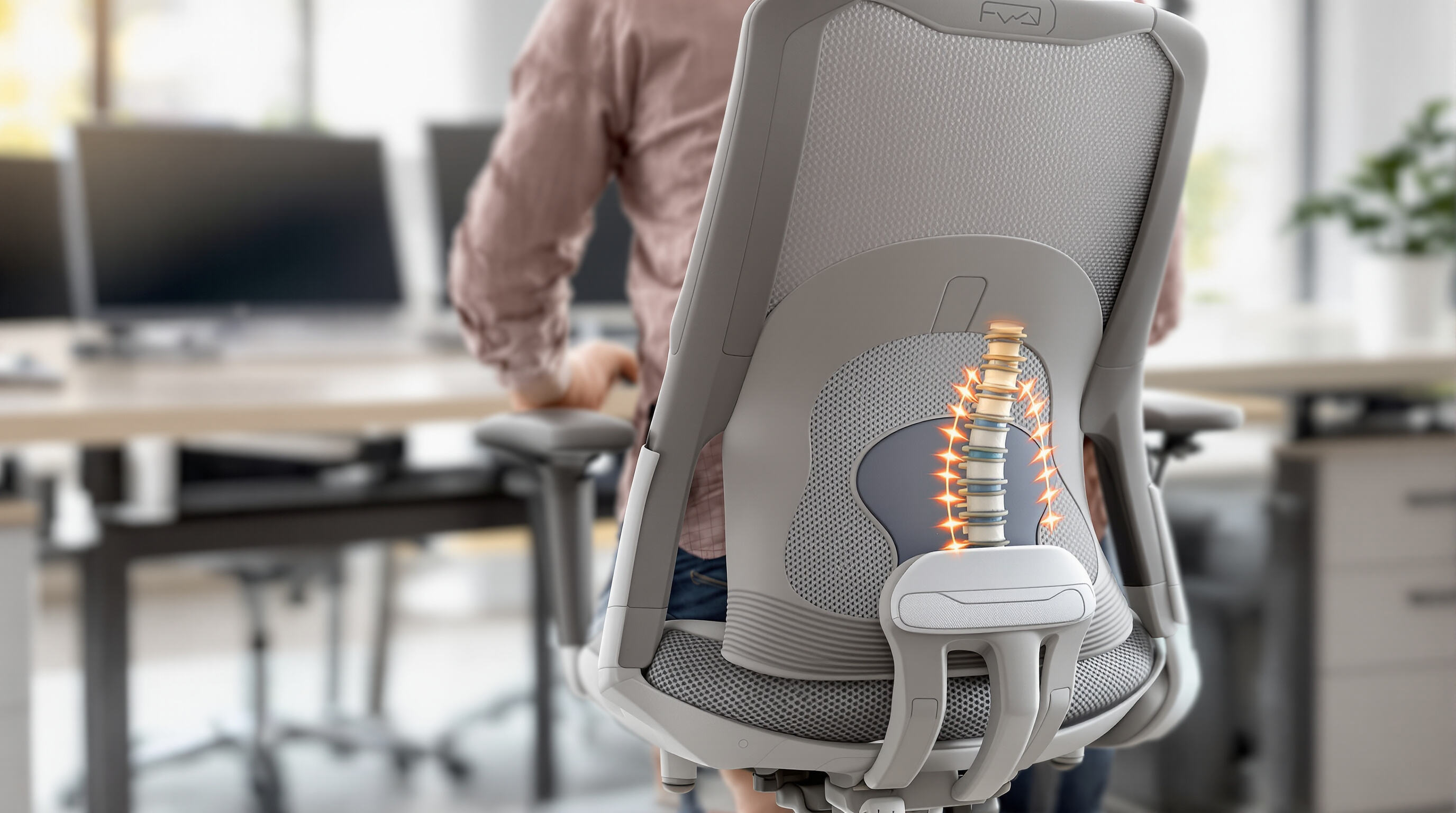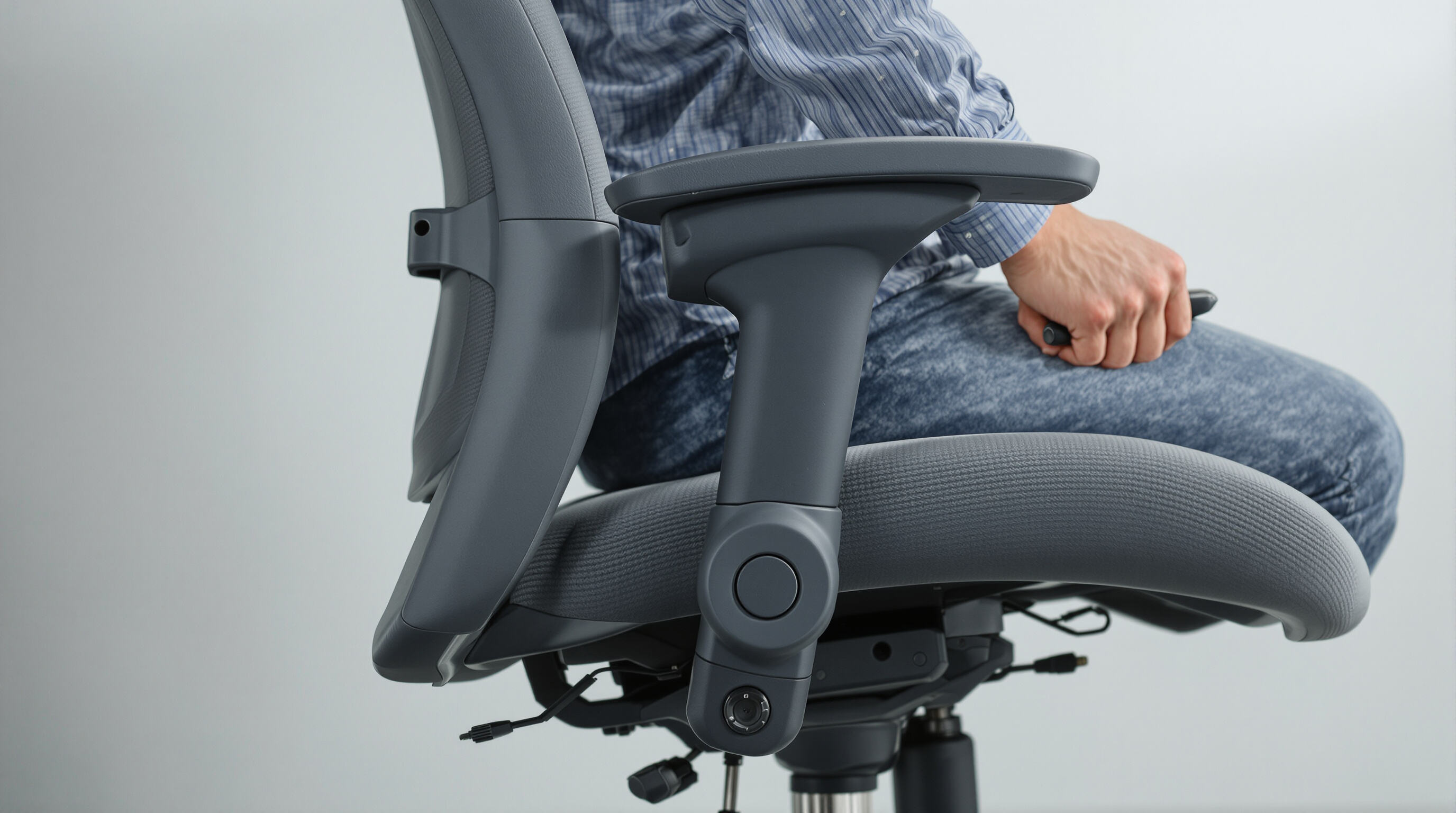The Science Behind Back Pain from Prolonged Sitting
How Sitting Affects Spinal Alignment and Disc Pressure
Prolonged sitting places 40% more pressure on spinal discs compared to standing, according to a 2023 ergonomics study. This compression flattens the lumbar spine’s natural curve, reducing shock absorption and straining supporting muscles. Over time, discs bear up to 90% of seated loads, increasing the risk of chronic pain.
Common Postural Mistakes in Desk-Based Work Environments
Three widespread errors worsen spinal stress:
- Slouching: Collapses the thoracic spine, shortening hip flexors and weakening core stabilizers
- Forward head posture: Adds 10–12 lbs of extra neck strain per inch of forward tilt
- Legs crossed: Unevenly loads pelvic joints and compresses sciatic nerves
Workers who sit over 6 hours daily face a 2.3 higher risk of developing musculoskeletal disorders (MSDs), with improper screen height and chair alignment accounting for 68% of preventable strain.
How Ergonomic Chairs Support Spinal Health and Reduce Pain

Lumbar Support and Its Role in Maintaining Natural Spinal Curvature
The right ergonomic chair can really help fight off the extra pressure on discs from sitting too long all day. Good ones have those curved supports in the lower back area that actually keep the spine in its natural S shape instead of letting it collapse. Flat backed chairs just don't cut it because they leave a gap where the lower back sags down. Quality chairs come with adjustable padding both vertically and horizontally so this gap gets filled properly. When someone sits correctly supported, their posture stays upright naturally without putting unnecessary stress on ligaments. According to some research published last year, when people get proper support for their lower backs, the muscles there work about 40 percent less hard throughout the day. That means workers who spend hours at desks feel less tired overall, which makes sense if we think about how much our backs ache after a long shift without good seating.
Ergonomic Design Principles That Alleviate Lower Back Pressure
Effective chairs integrate three key features:
- Seat depth adjusters to maintain 2–4 fingers of space between knees and seat edge
- Tilt tension controls enabling 100–110° recline for even weight distribution
- Waterfall seat edges reducing thigh pressure by 30% (Occupational Health Journal 2022)
Together, these elements prevent forward pelvic tilt—a posture that increases lumbar disc load by 90% when sustained beyond 60 minutes.
Do All Ergonomic Chairs Deliver on Back Pain Relief? A Critical Look
A lot of chairs on the market claim to be ergonomic, but the numbers tell another story. Around 78% come with those standard lumbar supports we all see, yet just about a third actually pass the adjustability tests from the International Ergonomics Association. Real comfort isn't possible without chairs that fit different body types properly. Take armrests for instance, some high quality models offer up to 20 positions so they work for someone who's 5 feet tall all the way up to someone standing at 6'5". Tests done by independent labs show something interesting too. Most chairs priced below $500 simply don't have the right mechanical components inside them to keep the spine aligned over time, which leads to discomfort and potential back problems down the road.
Key Adjustable Features of Ergonomic Chairs for Personalized Support

Seat Height, Depth, and Pelvic Alignment for Optimal Posture
Getting the seat height right means our feet can actually touch the ground properly, which takes some of that annoying pressure off the thighs. Seats that adjust depth wise are pretty important too since they stop blood flow problems from happening when sitting for long periods. There should be room enough between where the seat ends and the back of the legs so we can fit two or three fingers comfortably there. And if possible, adding those pelvic tilt features makes all the difference. These little tweaks together keep the spine in its normal curved position instead of letting it slump forward. That helps avoid those uncomfortable backaches and keeps discs from getting too stressed out during work hours.
Adjustable Armrests and Backrests to Reduce Muscle Strain
4D armrests that pivot, slide, and adjust vertically align shoulders and reduce neck tension. Synchronized backrests with tilt tension move with the user, distributing weight evenly across the back. This dynamic support reduces upper back muscle activation by up to 30% during typing compared to static chairs.
Dynamic Recline and Spinal Disc Hydration During Long Sitting
Chairs offering a 90°–135° recline range promote micro-movements that alternate pressure on spinal discs. This motion supports nutrient-rich fluid exchange in vertebral joints—a process shown to reduce disc dehydration by 18% during 8-hour sitting sessions.
Customization vs. One-Size-Fits-All: Addressing Individual Biomechanics
Top quality ergonomic chairs come with around 14 different adjustments, which is way more than what we see in standard office chairs that typically have between 3 and 5 settings. All these options really make a difference when it comes to fitting different body shapes. Some people need wider seats for their hips while others require deeper support for their lower back area. The problem with cheaper chairs is they try to fit everyone but end up working for no one. Studies suggest something like 7 out of 10 workers end up adding extra cushions or whatever they can find just to make those basic chairs comfortable enough to sit through a workday.
Material Comfort and Long-Term Use: Beyond Adjustability
Breathable materials and cushioning for sustained sitting comfort
Chairs designed for ergonomics featuring breathable mesh materials along with high density foam help keep users cool while spreading pressure evenly across sensitive areas. The advanced padding molds itself around different body shapes without collapsing under pressure, so people stay comfortable even after sitting for hours on end. Fabrics that respond to climate conditions need about a third less upkeep compared to regular fabric coverings and they don't sag or stretch as easily either. This makes them particularly good for places where humidity levels fluctuate throughout the day or where temperatures vary significantly from morning till night.
How chair materials influence posture and fatigue over time
The tension in textiles and how dense the foam is plays a big role in keeping the spine aligned when someone sits for long periods. Most memory foams do a good job at first, molding to the body shape nicely. But over time, typically around 18 to maybe even 24 months with regular everyday use, they start losing their springiness and just don't provide as much support anymore. On the flip side, those breathable knitted fabrics actually help promote small movements in posture while sitting. These little adjustments work the core muscles without anyone really noticing. Studies suggest this can cut down on pressure on the discs in the spine by roughly 40 percent when compared to materials that don't respond to movement at all.
Long-Term Benefits of Ergonomic Chairs in the Workplace
Reducing Chronic Back Pain and Musculoskeletal Disorders
According to Steelcase research from 2022, ergonomic chairs can cut down on spinal disc pressure by around 40% when compared to regular office chairs, which goes straight to fixing one of the main reasons people get back pain sitting at desks all day. These special chairs help keep the pelvis in a neutral position and support the natural curve in the lower back area, something that makes those important posture muscles tire out much slower – studies show this can be as much as 34% less fatigue over time. Looking at real world results, a three year long study across several workplaces showed that folks who used these chairs regularly saw their reports of musculoskeletal problems drop by nearly 28%. The biggest difference was actually noticed among workers who already had some sort of lower back trouble before starting to use them.
Impact on Productivity, Focus, and Employee Well-Being
Workers using properly adjusted ergonomic chairs demonstrate 17.8% higher task persistence in cognitively demanding work (OfficeLogix 2023). Reduced physical discomfort is linked to 22% fewer concentration lapses and 19% faster error-correction times. Companies with ergonomic chair programs report 31% lower presenteeism, as employees experience less pain-related distraction during critical tasks.
Case Insights: Users Achieving Pain Relief Through Ergonomic Adjustments
When one factory replaced 200 regular office chairs with adjustable ones featuring lumbar support, they noticed something pretty remarkable. Back pain related absences dropped by almost half (around 43%) just six months after installation. For people who spend roughly nine hours each day sitting at their desks, these new chairs actually added about two extra hours where their backs didn't hurt thanks to features like dynamic reclining and customizable seat depths. The real game changer came for those struggling with ongoing discomfort from sitting all day. About three quarters of employees suffering from chronic pain reported cutting down on painkillers by over half once they started using properly adjusted ergonomic seating solutions within around three months' time.
FAQ
What is the risk of prolonged sitting on spinal health?
Prolonged sitting can increase spinal disc pressure by 40%, flatten the lumbar spine’s natural curve, reduce shock absorption, and strain supporting muscles, raising the risk of chronic back pain.
How do ergonomic chairs help reduce back pain?
Ergonomic chairs feature lumbar support to maintain the natural spinal curvature, adjustable features to reduce pressure on the lower back, and help in evenly distributing body weight to alleviate pain.
Do all ergonomic chairs effectively relieve back pain?
Not all ergonomic chairs are effective. Only a few pass the International Ergonomics Association's adjustability tests, and real comfort requires chairs that fit various body types properly.
What features should I look for in an ergonomic chair?
Key features include adjustable seat depth, tilt tension controls, waterfall seat edges, and customizable armrests and backrests for personalized support.
How do chair materials affect posture and comfort?
Breathable materials with high-density foam help maintain posture and reduce fatigue. Memory foams may lose support over time, whereas knitted fabrics promote small posture adjustments.

